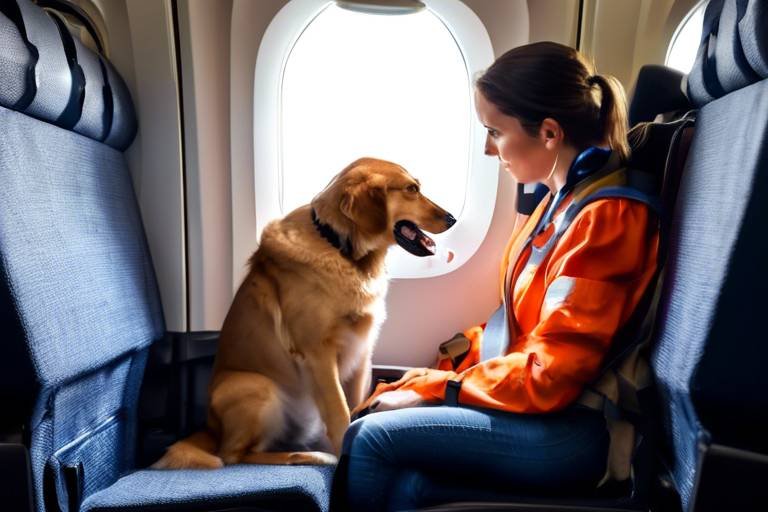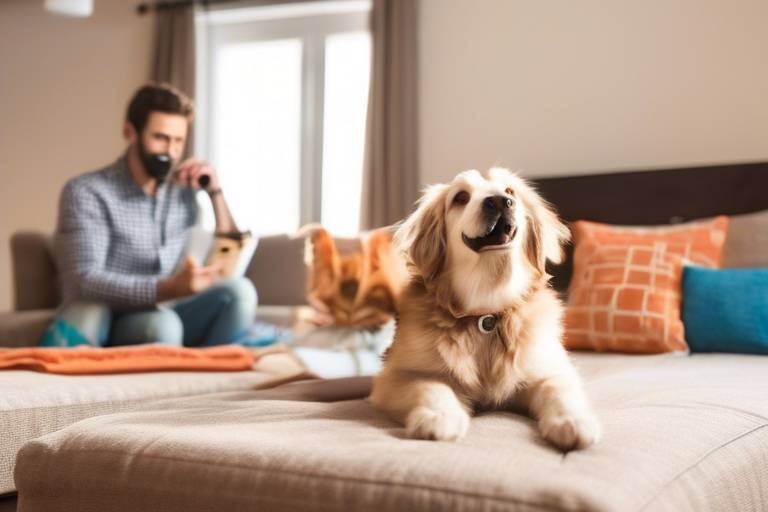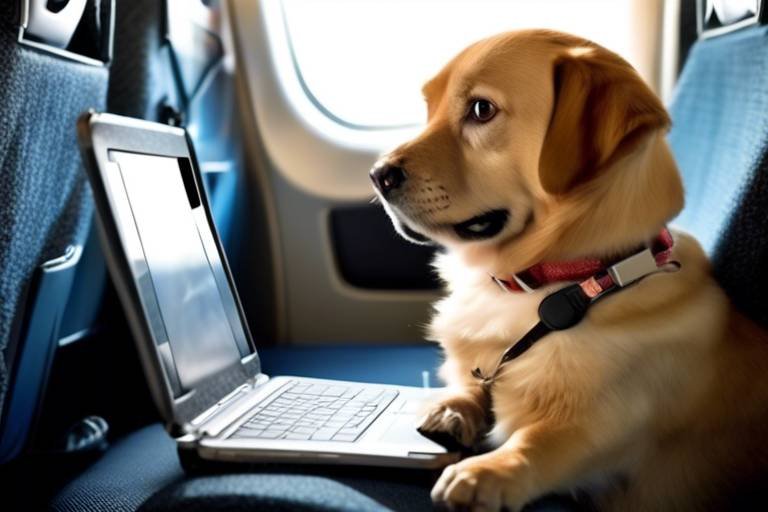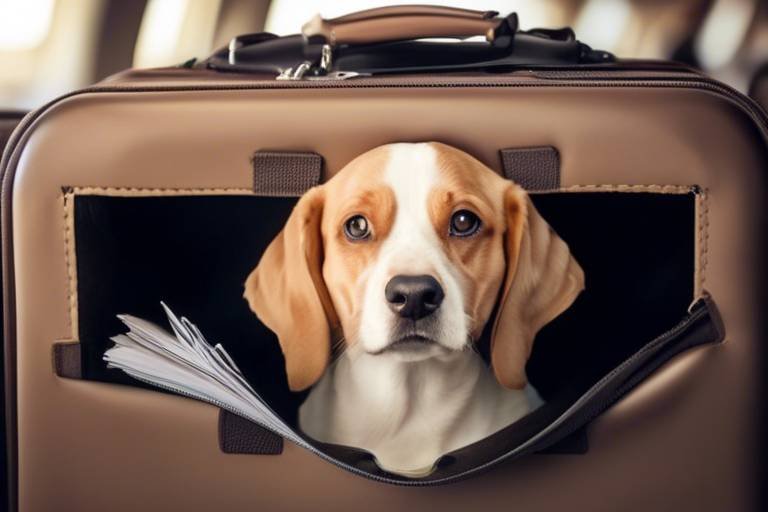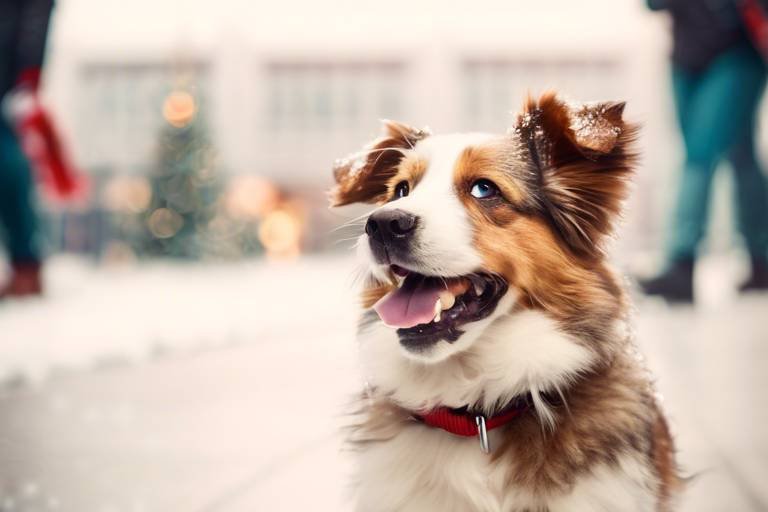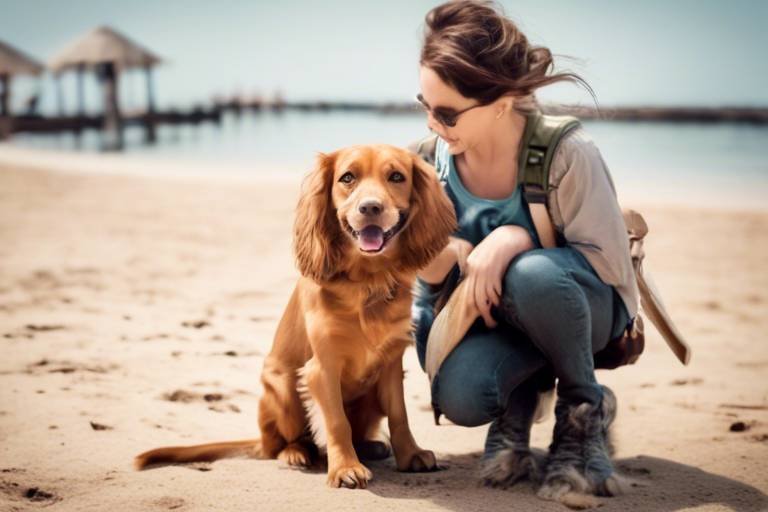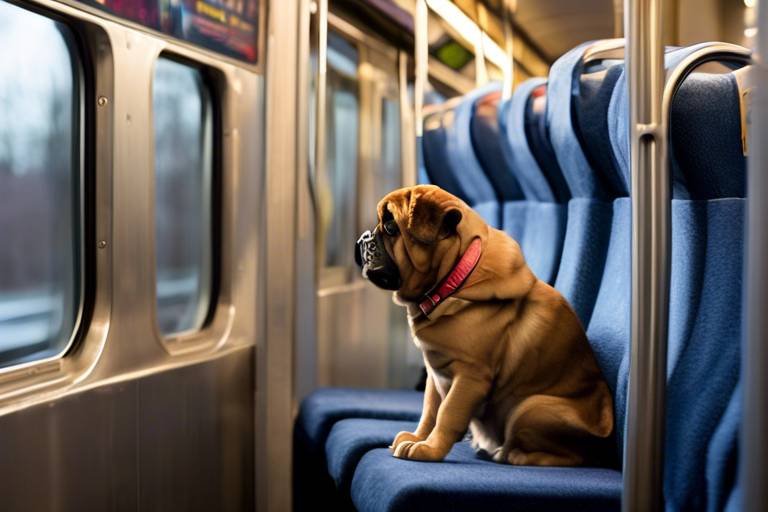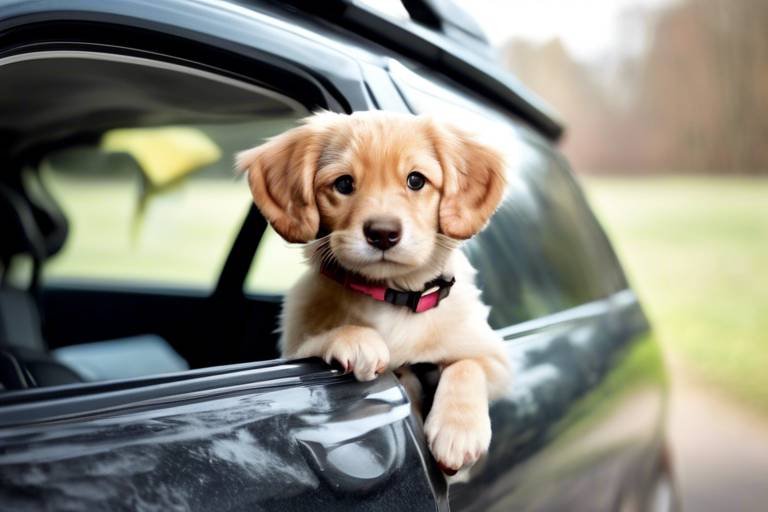Traveling with Pets - A Guide to Best Practices
Traveling with your beloved pets can be one of the most rewarding experiences, but it also comes with its own set of challenges. Imagine the joy of exploring new places with your furry companions by your side! However, to ensure a smooth journey, preparation is key. This article provides essential tips and best practices for traveling with pets, ensuring a safe and enjoyable journey for both you and your furry companions. From health checks to packing essentials, we’ll cover everything you need to know to make your travels as seamless as possible.
Before you even think about hitting the road, take a moment to prepare. A well-planned trip can save you from potential headaches down the line. First and foremost, schedule a visit to the vet. A health check-up is crucial, especially if you’re traveling long distances or crossing state lines. Ensure your pet is up-to-date on vaccinations and has a health certificate, which may be required by airlines or hotels.
Next, it's time to pack! Just like you wouldn’t leave home without your essentials, your pet deserves the same treatment. Here’s a quick checklist of must-have items:
- Food and water bowls
- Enough pet food for the entire trip
- Leash and collar with ID tags
- Comfort items like a favorite blanket or toy
- First aid kit for pets
Finally, plan your accommodations. Not all hotels are pet-friendly, so it’s essential to do your research. Websites like BringFido.com can help you find suitable lodging that welcomes pets. Always double-check the hotel’s pet policy and any additional fees they may charge.
Choosing the right mode of transportation can significantly impact your pet's comfort during travel. Whether you opt for a car, plane, or train, each has its own set of pros and cons. For instance, traveling by car offers flexibility and allows you to make stops along the way, which is great for stretching those little legs. On the other hand, air travel can be quicker but comes with its own set of challenges, such as crate requirements and airline policies.
When traveling by car, the journey can be enjoyable if planned correctly. It’s essential to keep your pet safe and comfortable during long drives. Consider using a pet carrier or a seat belt designed for pets. This not only keeps them secure but also minimizes distractions while driving. Regular breaks are crucial; aim to stop every couple of hours to let your pet stretch, relieve themselves, and hydrate.
Implementing safety measures is crucial. Here are a few best practices:
- Use a pet seat belt or carrier for safety.
- Never leave your pet unattended in a parked car, especially in extreme weather.
- Keep windows closed or only slightly open to prevent escape.
Keeping your pet comfortable during long drives is essential. Make sure the temperature inside the car is pleasant; pets can be sensitive to heat and cold. Bring along plenty of water and offer it to them regularly. A favorite blanket or toy can also help them feel more at home in the car.
Air travel with pets requires special considerations. Not all airlines allow pets in the cabin, and those that do often have specific crate requirements. It's crucial to familiarize yourself with the airline's pet policy ahead of time. To help your pet cope with flying, consider taking them on short car rides beforehand to get them accustomed to being in a crate. Additionally, make sure to arrive at the airport early to allow ample time for check-in and security procedures.
Finding suitable accommodations is vital for a successful trip. Many hotels welcome pets, but policies can vary widely. Look for pet-friendly hotels that offer amenities such as designated pet areas, pet beds, and even treats at check-in. Always read reviews from other pet owners to get a sense of how accommodating a hotel is.
When selecting a hotel, consider the following:
- Check for pet fees and weight restrictions.
- Look for hotels that provide pet-friendly services.
- Consider location—proximity to parks or pet-friendly attractions can enhance your stay.
In addition to hotels, alternative lodging options like vacation rentals and campsites can be pet-friendly. Websites like Airbnb often have filters that allow you to search specifically for pet-friendly properties. This can provide a more homely feel for you and your pet, making your trip even more enjoyable.
1. What should I do if my pet gets anxious while traveling?
Consider consulting your veterinarian for advice on calming aids or medications. Additionally, bring along their favorite toys or blankets to provide comfort.
2. Can I take my pet on public transportation?
Many public transportation systems have specific rules regarding pets. Always check the regulations before traveling.
3. How can I ensure my pet stays hydrated during the trip?
Bring a portable water bowl and offer water during breaks. You can also freeze some water in a bowl to keep it cool for longer.

Preparing for Your Trip
Preparation is key when traveling with pets. Before you embark on your adventure, it's essential to ensure that both you and your furry companions are ready for the journey ahead. First and foremost, schedule a health check for your pet. A visit to the veterinarian can help confirm that your pet is fit for travel, and you can also obtain any necessary vaccinations or health certificates, especially if you're crossing state lines or flying. Remember, a healthy pet is a happy pet!
Next, consider the essentials you’ll need to pack. Just like you wouldn’t leave home without your phone charger, your pet has their own set of must-haves. Here’s a quick checklist of items to include:
- Food and Water: Bring enough food for the trip, plus a little extra in case of delays. Don’t forget a portable water bowl!
- Leash and Collar: Ensure your pet has a secure collar with an ID tag, and always have a leash handy for bathroom breaks.
- Comfort Items: Bring along their favorite blanket or toy to help ease anxiety during travel.
- First Aid Kit: A basic first aid kit can be invaluable in case of minor injuries.
Additionally, planning your accommodations is crucial. Not all hotels welcome pets, so it's best to do your research ahead of time. Look for pet-friendly hotels or rentals that cater to furry guests. Websites like BringFido and Airbnb often have filters for pet-friendly options. When booking, double-check their policies regarding pet fees, size restrictions, and any specific rules they might have. It’s always better to be informed than to face unpleasant surprises upon arrival!
Finally, consider your pet's personality and needs. Some pets may be more anxious about travel than others. If your furry friend tends to get nervous, think about ways to help them feel more secure. This might include using a calming spray or pheromone collar, or simply giving them extra attention and reassurance. Remember, a little preparation can go a long way in ensuring a smooth and enjoyable trip for everyone involved!

Choosing the Right Transportation
When it comes to traveling with your beloved pets, one of the most critical decisions you'll face is selecting the right mode of transportation. Just like people, pets have their own preferences and comfort levels, and understanding these can make a world of difference in your travel experience. Are you considering a road trip, hopping on a plane, or perhaps taking a train? Each option comes with its own set of advantages and challenges, and making the right choice can ensure a smooth journey for both you and your furry companion.
First off, let’s talk about traveling by car. This is often the most popular choice for pet owners due to its flexibility. You can take breaks whenever needed, allowing your pet to stretch their legs, relieve themselves, and enjoy some fresh air. However, it's essential to keep safety in mind. Secure your pet in a crate or use a pet seatbelt to prevent any distractions while driving. Imagine your pet happily looking out the window, ears flapping in the wind, as you cruise down the highway. But remember, a little preparation goes a long way!
On the flip side, air travel can be a bit trickier. If you're planning to fly, you’ll need to check the airline’s pet policy well in advance. Some airlines allow pets in the cabin, while others may require them to be transported in the cargo hold. It’s crucial to choose an airline that prioritizes your pet's comfort and safety. Think about it: would you rather have your furry friend snuggled up next to you, or in a noisy, unfamiliar environment? The choice is clear! Additionally, investing in an airline-approved crate can make all the difference in easing your pet’s anxiety during the flight.
Trains are another option that many pet owners overlook. Amtrak, for example, allows small pets in carriers on certain routes. Traveling by train can be a unique experience, offering scenic views and a more relaxed atmosphere compared to flying. However, it’s vital to check the specific rules and regulations regarding pets on the train you plan to take. Can you imagine your pet enjoying the rhythmic clatter of the train while gazing out at the passing landscapes? It could be a delightful adventure for both of you!
To help you weigh your options, here’s a quick comparison of the three main transportation methods:
| Transportation Method | Pros | Cons |
|---|---|---|
| Car |
|
|
| Airplane |
|
|
| Train |
|
|
Ultimately, the best mode of transportation depends on your pet's personality, your travel plans, and how far you're going. Take the time to consider what will make your furry friend the most comfortable and happy. After all, a relaxed pet means a more enjoyable trip for everyone involved!
Traveling by Car
Traveling by car can be one of the most enjoyable ways to explore new destinations with your furry friend. Imagine the open road, the wind in your hair, and your pet happily wagging their tail beside you. However, as thrilling as it sounds, there are some important considerations to keep in mind to ensure both you and your pet have a safe and comfortable journey. First and foremost, it's crucial to plan your route carefully, making sure to include regular stops for bathroom breaks, exercise, and hydration. After all, a car ride can be just as exhausting for pets as it is for humans!
When it comes to keeping your pet secure in the car, using a pet carrier or a seat belt harness designed for animals is essential. Not only does this prevent your pet from roaming around and causing distractions, but it also protects them in case of sudden stops or accidents. Remember, just like you wouldn’t want to drive without a seatbelt, your pet deserves the same level of safety. Here’s a quick overview of some safety measures you can implement:
- Use a sturdy pet carrier that is well-ventilated.
- Secure your pet with a seatbelt harness or a pet seat cover.
- Avoid letting your pet stick their head out of the window, as this can lead to injuries.
Comfort is another critical factor during long drives. You wouldn’t want to be stuck in a car for hours on end without a comfortable seat, so why should your pet? Make sure to create a cozy space for your furry companion. Bring along their favorite blanket or bed to help them feel secure and at home. Additionally, maintaining a comfortable temperature in the car is vital. If it’s too hot or too cold, your pet can become stressed. Use air conditioning or heat as needed, and consider investing in sunshades for the windows to keep the interior cool.
Hydration is key during long journeys. Always have fresh water available, and consider packing a portable water bowl. This is especially important during the summer months when pets can easily become overheated. A quick tip: take breaks every couple of hours to allow your pet to stretch their legs and relieve themselves. This not only benefits your pet but also gives you a chance to refresh and enjoy the scenery!
Lastly, don’t forget to bring along some of your pet's favorite toys or chew items. Familiar scents can help reduce anxiety and make the trip more enjoyable. So, whether it's a squeaky toy or a beloved stuffed animal, these little items can make a big difference in keeping your pet calm and happy on the road.
Safety Measures in the Car
When it comes to traveling with your furry friends, ensuring their safety in the car is paramount. Just like you wouldn’t drive without a seatbelt, your pet deserves the same level of protection. The first step is to invest in a high-quality pet carrier or a harness seat belt. These tools not only keep your pet secure but also prevent distractions while you’re driving. Imagine how chaotic it could be if your dog suddenly decides to jump into your lap while you’re navigating a busy highway!
Additionally, it’s essential to keep your pet restrained in the back seat. The front seat is a no-go zone for pets; deploying airbags can pose serious risks to them. If you’re using a carrier, make sure it’s well-ventilated and securely fastened with the seatbelt. This way, your pet can enjoy the view while staying safe. Remember, a little preparation goes a long way in ensuring a smooth ride.
Now, let’s talk about the importance of taking regular breaks during long drives. Just like you would stop to stretch your legs and grab a snack, your pet needs those breaks too! It’s a great opportunity for them to relieve themselves, drink some water, and stretch their legs. Aim for a stop every two to three hours, and don’t forget to have a designated area for them to do their business. Be sure to keep a leash handy, as it’s crucial to keep them under control, especially in unfamiliar surroundings.
Here’s a quick checklist of safety measures to consider:
- Secure your pet in a carrier or with a harness seat belt.
- Keep your pet in the back seat to avoid airbag injuries.
- Take regular breaks every two to three hours.
- Always have a leash ready when stopping for breaks.
- Never leave your pet alone in a parked car, especially in hot weather.
Lastly, never underestimate the importance of keeping your car well-prepared. Bring along a pet emergency kit that includes essentials like food, water, a first aid kit, and any medications your pet may need. It’s also a good idea to familiarize yourself with local veterinary clinics along your route in case of emergencies. With these safety measures in place, you can embark on your journey with peace of mind, knowing that your pet is secure and comfortable.
Q: Is it safe to let my pet stick their head out the window?
A: While many pets love the feeling of wind in their fur, it’s not safe. Debris can fly into their eyes or cause injuries. It’s best to keep the windows rolled up or only slightly cracked.
Q: Can I travel with my pet in the front seat?
A: It’s not recommended. Airbags can be dangerous for pets, and they can also become a distraction. Always keep your pet secured in the back seat.
Q: What should I do if my pet gets car sick?
A: If your pet experiences motion sickness, consult your veterinarian for advice. They may recommend medication or tips to help your pet feel more comfortable during travel.
Q: How can I keep my pet calm during long drives?
A: Familiarize your pet with the car before long trips, take short drives to build their confidence, and consider using calming products or techniques, such as pheromone sprays or soothing music.
Comfort Tips for Long Drives
When embarking on a long road trip with your furry friend, ensuring their comfort is just as important as your own. Think of your pet as your travel buddy—would you want them to feel cramped and uncomfortable? Absolutely not! Here are some essential tips to keep your pet happy and cozy during those extended hours on the road.
First and foremost, temperature control is crucial. Just like humans, pets can feel too hot or too cold, and neither is a pleasant experience. Make sure to adjust the air conditioning or heating in your car to keep the temperature at a comfortable level. If your pet is in a crate, ensure it’s well-ventilated but not drafty. A good rule of thumb is to check the temperature every so often, especially during long stretches of driving.
Next, don’t forget about hydration. Keeping your pet hydrated is vital, especially on warm days. Bring along a spill-proof water bowl and stop regularly to offer your pet water. You can also consider bringing some ice cubes for them to chew on, which can be refreshing and entertaining. Remember, a happy pet is a hydrated pet!
Another important aspect is frequent breaks. Just like you need to stretch your legs and take a breather during a long drive, your pet does too! Plan to stop every couple of hours to allow your pet to relieve themselves, stretch, and explore a bit. These breaks not only help keep your pet comfortable but also give them a chance to burn off some energy. A quick walk around the gas station or a nearby park can do wonders for their mood.
Additionally, consider bringing along some of your pet’s favorite toys or blankets. Familiar items can provide a sense of security and comfort. If your dog loves their squeaky toy or your cat has a favorite blanket, having these items in the car can help them feel more at home. It’s like bringing a piece of their comfort zone along for the ride!
Lastly, if your pet tends to get anxious during car rides, you might want to consult your vet about calming aids. There are various products available, from natural supplements to anxiety wraps, that can help soothe your pet’s nerves. Remember, a calm pet is a comfortable pet!
In summary, keeping your pet comfortable during long drives involves a mix of temperature control, hydration, regular breaks, familiar comforts, and potentially calming aids. By paying attention to these details, you can ensure that both you and your furry companion have an enjoyable journey together!
- How often should I stop for my pet during a long drive? It's advisable to take a break every 2-3 hours to allow your pet to stretch, relieve themselves, and hydrate.
- Can I give my pet medication to help with anxiety during travel? Yes, consult your veterinarian for suitable calming aids or medications that may help your pet during travel.
- What should I pack for my pet on a road trip? Essentials include food, water, bowls, leash, waste bags, toys, and any medications your pet may need.
Traveling by Air
Air travel can be a thrilling adventure, but when it comes to bringing your furry friend along, it requires a bit more planning and consideration. Unlike road trips where you can simply hop in the car and go, flying with pets demands a comprehensive understanding of airline regulations, crate requirements, and the overall experience your pet will have during the journey. It's essential to ensure your pet feels as comfortable and secure as possible, so let's dive into some vital aspects to keep in mind.
First and foremost, researching airline policies is crucial. Different airlines have varying rules regarding pet travel, including size restrictions, fees, and whether pets can travel in the cabin or must be checked as cargo. For instance, some airlines allow small pets to accompany you in the cabin, while others may require them to travel in the cargo hold. Make sure to check the specific requirements of the airline you choose, as this will help you avoid any last-minute surprises at the airport.
Next, selecting the right crate is paramount. Your pet's crate should comply with the airline's specifications, which often include dimensions and ventilation requirements. A sturdy, well-ventilated crate can make all the difference in your pet's comfort. It's wise to introduce your pet to the crate before the trip, allowing them to explore and feel at ease. You can even make it a cozy space by adding familiar blankets or toys to reduce anxiety. Remember, a crate that feels like a safe haven will help your pet adjust to the flying experience.
As you prepare for your flight, consider how to help your pet cope with the stress of flying. Many pets can feel anxious in unfamiliar environments, and the airport can be a bustling, overwhelming place. To alleviate this, you might want to schedule a visit to the vet ahead of time. Discussing potential calming solutions, such as natural supplements or anxiety wraps, can be beneficial. Additionally, keeping your pet's routine as normal as possible leading up to the trip can help ease their nerves. Feed and walk them at their usual times to maintain a sense of stability.
On the day of travel, arrive at the airport with plenty of time to spare. Navigating security and boarding can be stressful, so giving yourself a buffer will allow you to handle any unexpected situations calmly. When checking in, ensure your pet is in their crate and comfortable. You can also ask the airline staff for any additional tips or assistance they may offer to ensure a smooth process.
While in the air, it’s essential to keep your pet calm. If your furry friend is traveling in the cabin, you can comfort them by speaking softly and offering treats. For those traveling in cargo, make sure to check on them as soon as you arrive at your destination. The first few moments after landing can be overwhelming for them, so having a familiar toy or blanket handy can provide comfort during this transition.
In summary, while flying with pets may seem daunting, with the right preparation, it can be a manageable and enjoyable experience for both you and your furry companion. By understanding airline policies, choosing the right crate, and keeping your pet calm, you'll set the stage for a successful adventure in the skies.
- Can my pet travel in the cabin with me? - This depends on the airline's specific policies and your pet's size. Many airlines allow small pets to travel in the cabin.
- What type of crate is required for air travel? - The crate must be well-ventilated, secure, and meet the airline's size requirements. It should also be comfortable for your pet.
- How can I help my pet cope with flying? - Consider consulting your vet for calming solutions and maintain your pet's routine leading up to the trip.
- What should I do if my pet gets anxious during the flight? - Speak softly to them, offer treats, and ensure they have familiar items in their crate to comfort them.

Accommodations for Pets
Finding suitable accommodations for your furry friend is not just a matter of convenience; it's crucial for their well-being during your travels. Imagine arriving at your destination after a long journey only to discover that your hotel doesn't allow pets. The stress of finding a last-minute alternative can be overwhelming for both you and your pet. To avoid such scenarios, it's essential to do your homework before booking your stay. Start by researching pet-friendly hotels and accommodations that cater specifically to travelers with pets. Look for places that offer amenities tailored to your pet's needs, such as designated pet areas, walking trails, and even pet-sitting services.
When searching for pet-friendly lodging, always check the hotel’s specific policies regarding pets. Some places may charge additional fees, while others may have restrictions on the size or breed of pets allowed. It’s a good idea to call ahead and ask about their pet policies to ensure there are no surprises upon arrival. Also, consider the location of the accommodation. Is it near parks or pet-friendly attractions? Having easy access to these areas can make your trip much more enjoyable.
There are various types of accommodations available that can be suitable for you and your pet. Here’s a quick overview of some options:
| Type of Accommodation | Pros | Cons |
|---|---|---|
| Pet-Friendly Hotels | Convenient, often have amenities for pets | Can be expensive, policies vary |
| Vacation Rentals | More space, home-like environment | May require additional cleaning fees |
| Campsites | Outdoor experience, great for active pets | Limited amenities, weather dependent |
In addition to traditional hotels, there are also alternative lodging options that can provide a more homely feel for you and your pet. Vacation rentals, for example, can offer more space and a kitchen, allowing you to prepare meals for yourself and your pet. Many of these rentals are located in scenic areas, giving you and your furry friend the chance to explore nature together. Just be sure to read the reviews and check the pet policies before booking.
Another option to consider is campsites, especially if you and your pet enjoy the great outdoors. Camping can be a fantastic way to bond with your pet while enjoying the beauty of nature. Just remember to bring along all the necessary supplies, such as food, water, and a comfortable sleeping arrangement for your pet. Make sure the campsite is pet-friendly and check for any specific rules regarding pets.
Ultimately, the key to a successful trip with your pet is planning ahead. By researching your options and understanding the policies of different accommodations, you can ensure that both you and your furry companion have a comfortable and enjoyable stay. So, pack your bags, grab your pet's favorite toys, and get ready for an adventure!
- What should I look for in a pet-friendly hotel? Look for amenities such as pet areas, walking trails, and specific pet policies, including fees and restrictions.
- Are vacation rentals a good option for traveling with pets? Yes, they often provide more space and a home-like environment, but check for pet policies and additional fees.
- Can I take my pet camping? Absolutely! Just ensure the campsite is pet-friendly and be prepared with all necessary supplies.
Pet-Friendly Hotels
When it comes to traveling with your furry companions, finding the right pet-friendly hotel can make all the difference. Not only do you want a place that welcomes your pet, but you also want to ensure that both you and your four-legged friend are comfortable during your stay. The variety of options available today can be both exciting and overwhelming, but don’t worry! We’re here to break it down for you.
First things first, it’s important to do your research. Not all hotels that claim to be pet-friendly are created equal. Some may have restrictions on the size or breed of pets, while others might charge hefty fees or deposits. To avoid any surprises, always check the hotel’s pet policy before booking. Many hotels offer amenities specifically designed for pets, such as:
- Pet beds and bowls
- Dog parks or designated walking areas
- Pet-sitting services or recommendations for local pet care
Another crucial factor to consider is location. A hotel that’s near parks, pet-friendly restaurants, or attractions can make your trip much more enjoyable. Imagine being able to take leisurely strolls with your dog right outside your hotel or grabbing a bite to eat at a nearby café that welcomes pets. It can turn an ordinary trip into a memorable adventure!
While searching for the perfect pet-friendly hotel, don't forget to read reviews from other pet owners. Websites like TripAdvisor and Yelp can provide insights into the experiences of fellow travelers. Look for comments about the hotel’s pet policies, cleanliness, and overall atmosphere. A hotel that goes the extra mile for pets often stands out in reviews.
To help you on your quest, here’s a quick comparison of popular hotel chains known for their pet-friendly policies:
| Hotel Chain | Pet Policy | Fees |
|---|---|---|
| La Quinta Inn & Suites | All pets welcome | No fees |
| Best Western | Varies by location | Up to $30 per night |
| Kimpton Hotels | No weight limit, no fees | No fees |
| Marriott | Varies by location | Up to $100 non-refundable fee |
Lastly, remember to pack your pet’s essentials. This includes their favorite toys, food, and any necessary medications. A familiar blanket can also help them feel more at home in a new environment. The more prepared you are, the smoother your stay will be. After all, a happy pet means a happy owner!
In conclusion, finding the right pet-friendly hotel is all about doing your homework and knowing what to look for. With a little effort, you can ensure that both you and your furry friend have a fantastic stay, making your trip enjoyable and stress-free. So, pack your bags, grab your pet, and get ready for an adventure that both of you will cherish!
Alternative Lodging Options
When it comes to traveling with your furry friends, the quest for the perfect place to stay can be both exciting and daunting. While traditional hotels are often the first choice, there are a plethora of that can provide a more personalized and enjoyable experience for both you and your pet. Imagine a cozy cabin in the woods or a charming vacation rental by the beach—these options can offer more space and a home-like atmosphere that traditional hotels might lack.
One popular choice is vacation rentals. Platforms like Airbnb and Vrbo have a variety of listings that welcome pets. These rentals often come equipped with full kitchens, yard space, and more room for your pet to roam. Plus, having a kitchen means you can prepare your pet's meals, ensuring they stick to their regular diet and avoid any tummy troubles. Just be sure to read the fine print regarding pet policies, as some hosts may have specific rules or additional fees.
If you’re feeling adventurous, consider camping! Many campsites allow pets, and there's nothing quite like the great outdoors to rejuvenate your spirit and bond with your pet. Whether you’re pitching a tent or renting a cozy cabin, camping can be an unforgettable experience. Just remember to pack all the essentials for your pet, including their favorite blanket, toys, and plenty of food and water. Check local regulations to ensure that pets are allowed in the area you plan to visit, and be mindful of wildlife and other campers.
For those who prefer a more structured environment, pet-friendly hostels can be an excellent option. These establishments often cater to travelers looking for budget-friendly accommodations while still being welcoming to pets. While they may not offer the same level of privacy as a rental or hotel, hostels can provide a unique opportunity to meet other travelers and share tips about pet-friendly activities in the area. Just make sure to confirm their pet policy before booking your stay.
Lastly, don't overlook bed and breakfasts. Many B&Bs are family-run and offer a warm, welcoming atmosphere. They often have specific pet-friendly rooms and may even provide pet amenities like treats or beds. Staying at a B&B can also give you a chance to connect with the owners, who can offer local insights and recommendations for pet-friendly spots nearby.
In summary, exploring alternative lodging options can significantly enhance your travel experience. Whether you choose a vacation rental, campsite, hostel, or a charming B&B, the key is to do your research. Always check the pet policies, read reviews, and ensure that your chosen accommodation meets the needs of both you and your pet. After all, a happy pet means a happy trip!
Q: Are vacation rentals usually pet-friendly?
A: Many vacation rentals are pet-friendly, but it's essential to check the specific listing for their pet policy and any additional fees.
Q: Can I take my pet camping?
A: Yes! Many campsites allow pets, but be sure to check the regulations of the specific site you plan to visit.
Q: What should I look for in a pet-friendly hotel?
A: Look for hotels that provide pet amenities, have clear policies on pet size and breed restrictions, and offer nearby parks or walking areas.
Q: Are there fees for bringing pets to accommodations?
A: Some places charge a pet fee or require a deposit, so always confirm before booking.
Frequently Asked Questions
- What should I do to prepare my pet for travel?
Preparing your pet for travel involves several steps, including scheduling a health check-up with your vet. Make sure your pet is up-to-date on vaccinations and has a proper identification tag. Additionally, pack essential items like food, water, medications, and comfort items such as their favorite blanket or toy to help them feel secure during the journey.
- Is it safe to travel with my pet in the car?
Yes, traveling with your pet in the car can be safe if you take the right precautions. Use a pet seat belt or a secure carrier to keep them safe during the drive. Make regular stops for bathroom breaks and to allow your pet to stretch their legs. Always ensure that your pet is comfortable and hydrated throughout the trip.
- What are the best practices for flying with pets?
When flying with pets, it’s essential to check the airline's specific pet policies, as they can vary widely. Ensure your pet’s crate meets airline requirements and is well-ventilated. To help your pet cope with the flight, consider familiarizing them with their crate ahead of time and consult your veterinarian about calming options if needed.
- How do I find pet-friendly accommodations?
Finding pet-friendly accommodations can be a breeze if you know where to look. Use websites and apps dedicated to pet-friendly lodging, and always read the fine print regarding their pet policies. Look for amenities that cater to pets, such as dog parks, pet beds, and nearby walking trails, to ensure a comfortable stay for both you and your furry friend.
- What should I pack for my pet during travel?
When packing for your pet, include the essentials like food and water bowls, a supply of their food, treats, and any necessary medications. Don’t forget items that provide comfort, such as their favorite toys, a blanket, and a leash. If you're traveling by air, also pack a travel crate that meets the airline's requirements.
- Can I leave my pet alone in a hotel room?
While some hotels allow pets to be left alone in the room, it’s best to check the specific policy of your accommodation. If you do leave your pet alone, make sure they are comfortable and have enough food, water, and toys to keep them occupied. It might be wise to bring a crate or carrier to give them a safe space while you’re out.



